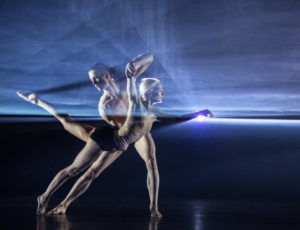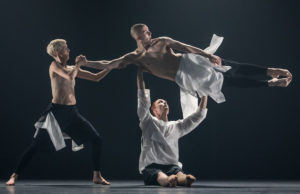Set to the electronic music of Jlin, who won the “Best Difficult Second Album” award at the 2017 AIM Music Awards, Company Wayne McGregor’s newest work Autobiography returned this company of formidable dancers and choreographers to San Francisco. Presented by SF Performances at the Yerba Buena Center for the Art Theater, the company’s sleek and endlessly compelling dance reveals that the demanding, for both dancers and audience, can be breathlessly wondrous.
Notes to Autobiography state that “McGregor turns his attention to the body as archive, as he embarks on a cycle of choreographic portraits illuminated by the sequencing of his own genome.” Hmmm. Both McGregor and his company members have been associated with scientific research for at least two decades, realizing that research as a long time, extensive questioning of how the choreographic process works. And that research has no doubt focused McGregor on the interior mechanisms of the body and the mysteriousness of what those mechanisms evoke in the mind. Without a doubt, what makes us tick is an endlessly complex and fascinating subject that spills over into time and matter.

Autobiography opens to a stage dense with smoke. The only light seems to emanate from a grid of schematic pyramidal structures suspended in the flies above the stage. The sets by Ben Cullen Williams were like a skeletal egg box turned upside down, rows of small lights delineating the bases of inverted pyramids. A solitary male stood in the midst of this cloudy and abstract formation. As he danced, his lean body unfolded, at times into movements something like ballet and at other times as a series of fragmented gestures: an arm swings like a pendulum, a finger points, both hands shape the curves of a sonic wave. The sounds surrounding him sounded like glass breaking. There was an acrobatic handstand, and his body distorted into hyperextension. The solo was long, involved, and without pause.
As two couples joined the soloist, the music took on the rhythmic pulse of a heartbeat. The floor became a support, rather than the end of a gravity-driven fall. The dancers were entangled and each other’s agents, moving each other’s leg, arm, hand. Volition seemed challenged, erased.
 The dancers on stage were replaced by two women in duet. They picked up the movement developed in the preceding section. Voices layered in the music: “You don’t want to hurt anyone,” says one voice. “Yeah, I do,” answers another. There were short bursts of strobe light followed by black outs.
The dancers on stage were replaced by two women in duet. They picked up the movement developed in the preceding section. Voices layered in the music: “You don’t want to hurt anyone,” says one voice. “Yeah, I do,” answers another. There were short bursts of strobe light followed by black outs.
The lighting throughout the piece, by Lucy Carter, often projected into the audience, creating shapes through the darkness. At times this was beautiful, at other times it was just annoying. If you have to warn the audience that you are going to shoot migraine-inducing strobes into their eyes (for what reason exactly?), then don’t use them. It’s an assault, not an interaction.
Once the interlude of nightmarish lighting ended, the performance became more compelling. These are profoundly skilled dancers, and they formed and were formed into choreography that is profoundly complex. It often gave the sense of being random, but it was far from random. Though moments of improvisation were possible, more often the dancers needed to be in place in relation to each other, either to provide support or to move in synchronistic phrases of several steps. The mere speed of the choreography demanded concentration and focus, and that needed to be maintained over the 80 continuous minutes of the composition.
Autobiography proves over and over the miracle of the body and the mind, of the depth of the human body and the preciousness of its existence in a staggeringly large universe of atomic particles and dark matter, emptiness and abundance.
– Jaime Robles
